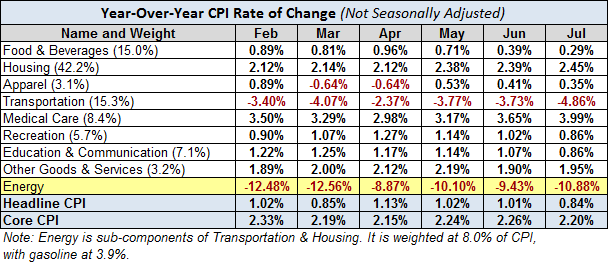Here is a table showing the annualized change in Headline and Core CPI, not seasonally adjusted, for each of the past five months. I’ve also included each of the eight components of Headline CPI and a separate entry for Energy, which is a collection of sub-indexes in Housing and Transportation.
We can make some inferences about how inflation is impacting our personal expenses depending on our relative exposure to the individual components. Some of us have higher transportation costs, others medical costs, etc.
A conspicuous feature in the table through the latest data is the volatility of energy, essentially the fluctuation in gasoline prices, which is also reflected in Transportation.

Here is the same table with month-over-month numbers (not seasonally adjusted). The change in energy costs is clearly illustrated, reflected here too in transportation.

The Trends in Headline and Core CPI
The chart below shows Headline and Core CPI for urban consumers since 2007. Core CPI excludes the two most volatile components, food and energy. I’ve highlighted the 2% to 2.5% range that the FOMC targeted in their December 12, 2012 press release, although the Fed has traditionally used the Personal Consumption Expenditure (PCE) price index as their preferred inflation gauge.


Year-over-year Core CPI (the blue line) made a moderate arc above the 2% benchmark beginning October of 2011. It dropped below the 2% – 2.5% range in August of 2012, but grazed the bottom of that range in February and July of last year. Core CPI has been below 2% for 19 of the last 23 months. The more volatile Headline CPI has spent 22 of the past of the past 23 months under the 2% lower benchmark. Much of the volatility in the past few years has been the result of broad swings in gasoline prices (more on gasoline here).
For a longer-term perspective, here is a column-style breakdown of the inflation categories showing the change since 2000.

